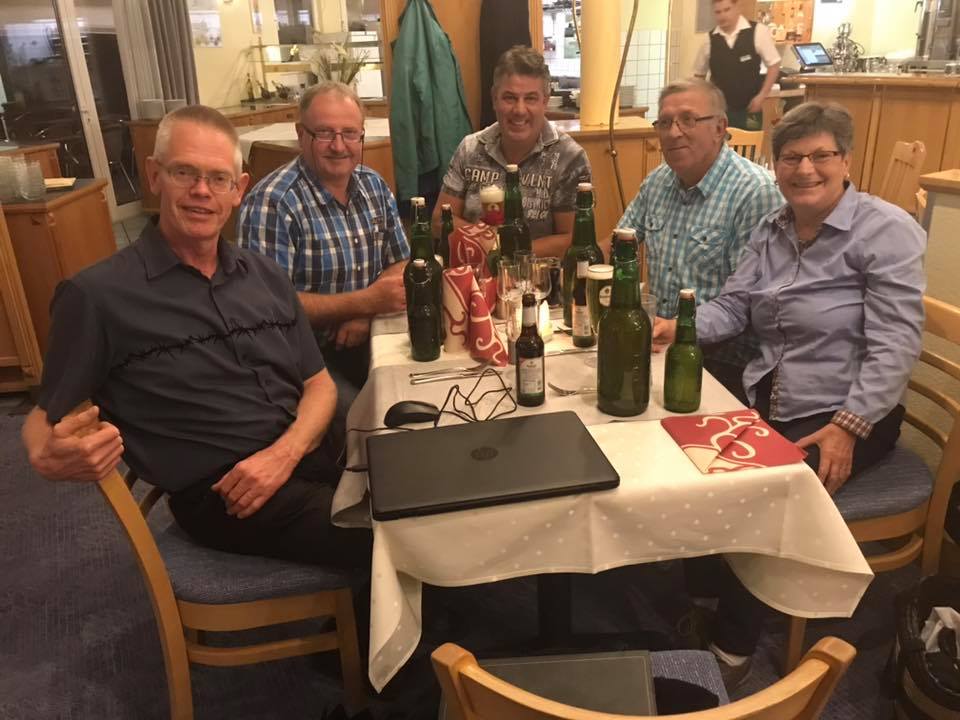48. A week with Weis(s)enborns in west-Thüringen in real life and in the archives, and how many present-day American Weissenborns are related via the village of Flarchheim
Posted on Facebook on 11 November 2018. I have spent the five days from Monday 15 October until Friday 19 October in the archives of the evangelical church in Eisenach, Erfurt and Bad Langensalza, and the city archive of Bad Langensalza. I had planned for this week already in April, knowing by experience that these archives have limited capacity: four film viewers in Eisenach, one in Erfurt, place for two, maybe three persons in the city archive of Bad Langensalza and only one place in the church archive there. I have thoroughly enjoyed this week. I have stayed with the custodian of the church in Niederdorla and her husband, Doris and Helmut Schulz. They had invited me to stay with them in 2017, after I had spent the day studying the church registers and a torrential rain in the evening threatened to spoil my night in my tent on the camp site in Mihla. I declined the kind offer then. I was happy that the rain stopped shortly after 9 pm and my tent had proved to be still water tight after 30 years. When I called Doris to ask if I could see the church registers once more, she immediately asked where I would stay. When I said I hadn't made up my mind - maybe camping in October would be possible - she pretty much decided that was nonsensical, and I should accept her invitation this time, and for the whole week. I did, gladly. I also had an invitation from Bodo Weißenborn: should I be again in the vicinity of Arnstadt - located south of Erfurt -, then he would like to meet me. I contacted Bodo well in time and ended up having a delightful evening on Monday with him, his brother Dietmar, sister Thea and a brother-in-law, see attached picture. And then there were the several hunderd Weißenborns I met in the registers. My research is in the phase of merging: I search for and often find the data that link a family twig to other twigs or trees. My anticipation is that I will end up with some 50 trees originating between 1550 and 1650, containing on average some 200 leaves = persons. The age of the oldest church registers that have survived determines who has become the founding father. If older registers of the village in which he lived will surface, the honor will pass to his father or even grandfather. On this facebook page I shall report about my recent findings in the archives. I shall do so theme by theme, as I have searched for data in that way. In this first post I shall relate my most surprising and discouraging discovery, which I made in the mornings of Tuesday and Wednesday. On Tuesday morning, in the city archive of Bad Langensalza, I was handed the family trees Weissenborn compiled in 1934 by the retired city archivist Hermann Gutbier. He had investigated the city as well as many neighbouring villages, amongst which Flarchheim, see attached map. I had virtually exhaustively studied the church registers of Niederdorla, a village from which many present-day American Weissenborns originate. I knew that many (if not all) Weissenborns in Niederdorla originated from Flarchheim. The work by Hermann Gutbier came as a welcome surprise. But the real titillating surprise came when I read the line "Christoph Christian, born 1820", son of Johann Christoph and Anna Martha Thilo. I had a Christoph Christian born in Prussia on 17 December 1820 in my database, with many descendants in America in the present, as he emigrated to Vandalia, Montgomery Ohio in 1849. So far I had not found any clue where to look for him in Prussia. And here he was, in Flarchheim, as a gift from Hermann Gutbier! Of course I wanted to see the film with the church registers of Flarchheim first thing the next day in the church archive in the Augustiner Kloster in Erfurt. I knew that the registers had survived from 1736 and that Hermann Gutbier had consulted them in 1934. However: the archivist Michael Ludscheidt in Erfurt looked rather puzzled. The registers of Flarchheim that he had on film dated back only to the early 1820s. The registers from 1736 until those years must have gone missing since 1934. Bad news: church registers that had survived for 200 years had gone missing in the last 80 years. War seems an unlikely cause; theft a quite likely one. With the notes of Hermann Gutbier I have been able to identify as the earliest ancestors of many American Weissenborns the two brothers Heinrich and Georg Andreas, who lived in Flarchheim and were born in about 1686 and 1692, respectively. Their family tree now contains an offspring of 216 persons. In the citizen register of Mühlhausen a Hans Weißenborn from Flarchheim is recorded who acquired citizenship in 1633. It stands to reason that some three generations back the forebear of Heinrich, Georg Andreas and their brother Hans Georg was a brother, cousin or other close relative of this Hans, and has lived in Flarchheim from about 1600 onwards. For those interested in the family tree of the Weissenborns from Flarchheim: you can check out this tree on my webpage, weisenborn-boer.nl/Weissenborn_Wittenborn/Stambomen/data.htm, by searching for Flarchheim and clicking on the members who are listed alphabetically.
